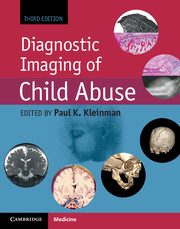Book contents
- Frontmatter
- Dedication
- Contents
- List of Contributors
- Editor’s note on the Foreword to the third edition
- Foreword to the third edition
- Foreword to the second edition
- Foreword to the first edition
- Preface
- Acknowledgments
- List of acronyms
- Introduction
- Section I Skeletal trauma
- Section II Abusive head and spinal trauma
- Section III Visceral trauma and miscellaneous abuse and neglect
- Section IV Diagnostic imaging of abuse in societal context
- Section V Technical considerations and dosimetry
- Chapter 28 Radiologic image formation: physical principles, technology, and radiation dose considerations
- Chapter 29 The physics and biology of magnetic resonance imaging: medical miracle anyone?
- Chapter 30 Quality assurance and radiographic skeletal survey standards
- Index
- References
Chapter 30 - Quality assurance and radiographic skeletal survey standards
from Section V - Technical considerations and dosimetry
Published online by Cambridge University Press: 05 September 2015
- Frontmatter
- Dedication
- Contents
- List of Contributors
- Editor’s note on the Foreword to the third edition
- Foreword to the third edition
- Foreword to the second edition
- Foreword to the first edition
- Preface
- Acknowledgments
- List of acronyms
- Introduction
- Section I Skeletal trauma
- Section II Abusive head and spinal trauma
- Section III Visceral trauma and miscellaneous abuse and neglect
- Section IV Diagnostic imaging of abuse in societal context
- Section V Technical considerations and dosimetry
- Chapter 28 Radiologic image formation: physical principles, technology, and radiation dose considerations
- Chapter 29 The physics and biology of magnetic resonance imaging: medical miracle anyone?
- Chapter 30 Quality assurance and radiographic skeletal survey standards
- Index
- References
Summary
Quality assurance
Quality assurance (QA) and quality control (QC) are fundamental to the establishment and ongoing analysis of imaging strategies. All parameters of the imaging chain must meet specific criteria and be critically evaluated on a continuous basis. A solid QA/QC program can be implemented to ensure consistent, high-quality diagnostic imaging in cases of suspected child abuse (1–7).
Radiographic QA sets standards for the production of optimal quality images obtained at the lowest radiation dose to the patient. Radiographic QC, a component of QA, is the overall system of activities whose purpose is to ensure integrity of the imaging equipment and provide consistent quality images. QA also includes examination screening for appropriateness, equipment calibration, preventive maintenance, in-service education of radiologic technologists, acceptance testing of new radiographic equipment/digital imaging chain components, and evaluation of new imaging products.
The implementation of QA in the healthcare environment has been an important step in reinforcing and improving standards of care. A well-designed QA program should regulate the production, quality, and maintenance of consistent imaging. Radiology departments should seek to prospectively build QA and QC into their imaging services rather than retrospectively attempt to correct failures. As greater control is obtained over imaging practices and as observations and trends are noted, new areas for improved quality may be illuminated (1, 3, 4, 8, 9).
- Type
- Chapter
- Information
- Diagnostic Imaging of Child Abuse , pp. 708 - 715Publisher: Cambridge University PressPrint publication year: 2015



